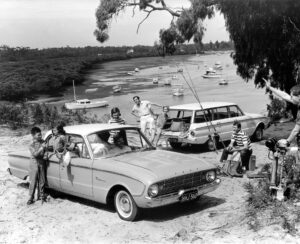On October 6, 1974, a Ford Falcon XA Hardtop thundered home to win Australia’s most famous motor race, the Hardie Ferodo 1000. In rain-drenched conditions Kevin Bartlett, co-driver for privateer John Goss, brought the big coupe home ahead of a rabble of Holden’s then-new Torana V8s.
This year (2024) marks 50 years since that memorable victory at the iconic circuit – the second for a Ford Falcon Hardtop, after Allan Moffat’s factory-backed win in 1973.
Since then, the Falcon Hardtop’s status with Aussie enthusiasts has grown to be far higher than might rightly have been expected from its relatively short, six-year model cycle.
Racing success – in particular its Bathurst victories in the hands of Allan Moffat/Ian Geoghegan in ’73, John Goss/Kevin Bartlett in ’74, and the magic 1-2 finish in 1977 of Moffat/Jacky Ickx Colin Bond/lan Hamilton – have made this one of the most iconic of all Aussie muscle cars.
Add to this the Falcon Hardtop’s starring role as the Interceptor, driven by a vengeful Max Rockatansky (Mel Gibson) in George Miller’s 1979 blockbuster Mad Max; and two decades later cruising the mean streets of Sydney’s Kings Cross with Pando (Bryan Brown) and his underworld thugs in Two Hands, and it’s easy to see how these distinctive home-grown coupes have come to be such a revered part of Aussie automotive culture.

After John Goss’ victory at the Bathurst 1000 in 1974, Ford released the XB Falcon Hardtop “John Goss Special” in his honour the following year
How the humble Falcon sedan laid the platform for Ford’s barnstorming V8 coupes
The XK Ford Falcon arrived in Australia in September 1960. At first, it was a cookie-cutter version of the new-for-1960 US-market Falcon, with mostly light revisions other than the significant engineering required to make the switch from left- to right-hand drive.
In affluent America the monocoque-design Falcon was a ‘compact’ car intended to be the second vehicle in a household; mom’s car beside dad’s Fairlane in the driveway, or a first car for the then-teenaged baby-boomers.
For Australia, the Falcon replaced the British-origin Zephyr as Ford Australia’s family car. Local Ford execs thought Falcon would be a better bet against GM’s popular locally-made Holden.
Ford was in the process of building its new vehicle assembly plant in Broadmeadows, Vic, at the time and had to quickly change tack when the decision came to replace Zephyr with Falcon.

The first XK Falcon arrived in September 1960, with it largely the same as the US-market Falcon of the time
The first Falcon range included a four-door sedan and wagon, plus a utility and low-roofed panel van. Promoted as “Australian – with a world of difference,” the Falcon, with its airy, fresh, mid-century modern appearance was a styling masterpiece.
Unfortunately, the car’s US design origins meant the suspension was ill-equipped to cope with Australia’s punishing road conditions.
Mechanics in Ford dealers around the country were kept busy fixing the first-gen Falcon’s weak underpinnings, a process that ultimately led to Ford Australia chassis engineers developing new hardware.
Launched in 1966, the second-generation XR Falcon was wider and longer than its North American-based predecessor, introducing the basic chassis dimensions and architecture that would underpin the Aussie Falcon for the next 50 years.
Subsequent series updates slowly evolved the design to the more bespoke Australian vehicle we’ve come to know and love. These included the simple tweaks for the XT, such as its horizontally-banded rear indicator lenses, to more comprehensive changes with the XW (June 1969) and XY (October 1970), so that the Falcon eventually retained little more than the door skins from the 1966 XR.

By the time the ’70s rolled around, little was retained of the original second-generation XR’s design beyond the door skins
Mechanically, the big news for the 1966 XR was the introduction of a V8 option, an imported 289-ci (4.7-litre) unit. The V8 was soon adopted as the heart and soul of the new XR GT, a performance four-door sedan based loosely on a package developed for police.
For much of the 1960s, the smaller four-cylinder Cortina had been Ford’s champion on the nation’s race tracks – including the 500-mile Gallaher 500, as the Bathurst 1000 was then known.
The arrival of a V8-powered GT Falcon gave Ford a ready-made ‘race special’ with which to replace the diminutive Cortina, and the XR GTs didn’t disappoint, finishing first and second in the 1967 edition of the Great Race, driven by Harry Firth/Fred Gibson and Leo and Ian Geohegan.
Bathurst was becoming increasingly important for selling cars and with subsequent Falcon GT developments – through the XT and XW series to the XY GTHO Phase III – Ford grabbed the marketing opportunity with both hands.
In the next instalment: How Ford Australia product planners fudged the numbers to make the Falcon XA Hardtop a reality.

The arrival of the third-generation Falcon, starting with the XA, would usher in even more of an Aussie flavour








